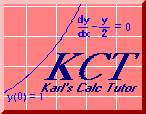

Step 1: The problem was to find the limit for
1 - cos(h)
lim
h > 0 h2
And the hint was to use the
difference of squares
to simplify it. That suggests that you multiply top and bottom by
Step 2: You should have gotten
1 - cos2(h)
lim
h > 0 h2 (1 + cos(h) )
You should be able to see a trig identity that you can immediately
apply to the numerator of this thing. Go ahead and apply it, and
then
Step 3: The trig identity that you should have applied is
sin2(h)
lim
h > 0 h2 (1 + cos(h) )
Ok, you already know about the limit of sin(h)/h. You should
be able to use that to infer what the limit of
sin2(h)/h2 is. And in the limit, that
leads to a cancellation. Go ahead and drop the terms that that
eliminates. Then Step 4: The limit of sin2(h)/h2 is one as h goes to zero. So the sin2(h) term in the numerator cancels with the h2 term in the denominator. That leaves you with
1
lim
h > 0 1 + cos(h)
You know what cos(h) approaches as h approaches zero.
So use that and take the limit. When you are done,
As h gets closer and closer to zero, cos(h) gets closer and closer to one. So this limit looks more and more like
1 1
lim =
h > 0 1 + 1 2
So the answer is 1/2.
email me at hahn@netsrq.com